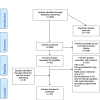Using Acoustic Speech Patterns From Smartphones to Investigate Mood Disorders: Scoping Review
- PMID: 34533465
- PMCID: PMC8486998
- DOI: 10.2196/24352
Using Acoustic Speech Patterns From Smartphones to Investigate Mood Disorders: Scoping Review
Abstract
Background: Mood disorders are commonly underrecognized and undertreated, as diagnosis is reliant on self-reporting and clinical assessments that are often not timely. Speech characteristics of those with mood disorders differs from healthy individuals. With the wide use of smartphones, and the emergence of machine learning approaches, smartphones can be used to monitor speech patterns to help the diagnosis and monitoring of mood disorders.
Objective: The aim of this review is to synthesize research on using speech patterns from smartphones to diagnose and monitor mood disorders.
Methods: Literature searches of major databases, Medline, PsycInfo, EMBASE, and CINAHL, initially identified 832 relevant articles using the search terms "mood disorders", "smartphone", "voice analysis", and their variants. Only 13 studies met inclusion criteria: use of a smartphone for capturing voice data, focus on diagnosing or monitoring a mood disorder(s), clinical populations recruited prospectively, and in the English language only. Articles were assessed by 2 reviewers, and data extracted included data type, classifiers used, methods of capture, and study results. Studies were analyzed using a narrative synthesis approach.
Results: Studies showed that voice data alone had reasonable accuracy in predicting mood states and mood fluctuations based on objectively monitored speech patterns. While a fusion of different sensor modalities revealed the highest accuracy (97.4%), nearly 80% of included studies were pilot trials or feasibility studies without control groups and had small sample sizes ranging from 1 to 73 participants. Studies were also carried out over short or varying timeframes and had significant heterogeneity of methods in terms of the types of audio data captured, environmental contexts, classifiers, and measures to control for privacy and ambient noise.
Conclusions: Approaches that allow smartphone-based monitoring of speech patterns in mood disorders are rapidly growing. The current body of evidence supports the value of speech patterns to monitor, classify, and predict mood states in real time. However, many challenges remain around the robustness, cost-effectiveness, and acceptability of such an approach and further work is required to build on current research and reduce heterogeneity of methodologies as well as clinical evaluation of the benefits and risks of such approaches.
Keywords: data science; diagnosis; monitoring; mood disorders; smartphone; speech patterns.
©Olivia Flanagan, Amy Chan, Partha Roop, Frederick Sundram. Originally published in JMIR mHealth and uHealth (https://mhealth.jmir.org), 17.09.2021.
Conflict of interest statement
Conflicts of Interest: AC reports grants and consultancy fees from Janssen-Cilag, consultancy fees from Spoonful of Sugar Ltd, grants from A+ charitable trust (Auckland District Health Board), Maurice and Phyllis Paykel trust, Universitas 21, New Zealand Pharmacy Education Research Fund, Auckland Academic Health Alliance, Asthma UK, Health Research Council, Oakley Mental Health Foundation, Chorus, the University of Auckland, and is the recipient of the Robert Irwin Postdoctoral Fellowship, outside the submitted work.
Figures
References
-
- Bonnín C M, Torrent C, Goikolea JM, Reinares M, Solé B, Valentí M, Sánchez-Moreno J, Hidalgo D, Tabarés-Seisdedos R, Martínez-Arán A, Vieta E. The impact of repeated manic episodes and executive dysfunction on work adjustment in bipolar disorder. Eur Arch Psychiatry Clin Neurosci. 2014 Apr 3;264(3):247–54. doi: 10.1007/s00406-013-0431-2. - DOI - PubMed
-
- Whiteford HA, Degenhardt L, Rehm J, Baxter AJ, Ferrari AJ, Erskine HE, Charlson FJ, Norman RE, Flaxman AD, Johns N, Burstein R, Murray CJ, Vos T. Global burden of disease attributable to mental and substance use disorders: findings from the Global Burden of Disease Study 2010. The Lancet. 2013 Nov;382(9904):1575–1586. doi: 10.1016/s0140-6736(13)61611-6. - DOI - PubMed
-
- Stafford MR, Jackson H, Mayo-Wilson E, Morrison AP, Kendall T. Early interventions to prevent psychosis: systematic review and meta-analysis. BMJ. 2013 Jan 18;346(jan18 1):f185–f185. doi: 10.1136/bmj.f185. http://europepmc.org/abstract/MED/23335473 - DOI - PMC - PubMed
Publication types
MeSH terms
LinkOut - more resources
Full Text Sources
Miscellaneous



